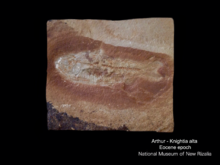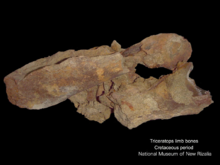National Museum of New Rizalia
 Logo of the museum | |
| Established | 2014 (as the La Cresta Museum of Fossils and Artifacts) |
|---|---|
| Location | |
| Type | Micronational |
| Collection size | approx. 4,000 specimens |
| Curator | Seann Torres |
The National Museum of New Rizalia (NMNR), is a natural history museum located at the Government Center in Entrada Ventana, New Rizalia. The museum was established in 2014, with the mission "to preserve and propagate the wonders of the universe."
The museum's collections contain over 4,000 specimens of fossils, rocks, meteorites, antiquities, foreign currency, and cultural artifacts, making it among the largest micronational museum collections in the world. The entire collection is exhibited annually from November 28 to October 1 at the St. Adelaide's Carnival in Highland, California.
History
Founding
The National History Museum of New Rizalia was established in 2014 by Seann Torres, as the La Cresta Museum of Fossils and Artifacts. The museum's first specimens were fossils of Otodus obliquus, an ancestor of the famous Carcharocles megalodon, and other small shark teeth from Morocco. These first fossils inspired the museum to expand its collection.
The museum was later incorporated into the Republic of New Rizalia and renamed the National Museum of New Rizalia.
Collections
Paleontology
The paleontological collection is the largest collection within the NMNR, consisting of an estimated 3,000 specimens. The age of these fossils range from as old as 2.5 billion years to as recent as 9,000 years ago. The collection is divided into two categories: vertebrate and invertebrate fossils.




Notable fossils
The museum has many valuable and significant fossils, including:
- Arthur the Fish: The mascot of the museum. Arthur is a Knightia alta specimen originally collected in the 20th century by famous Californian designer, Arthur Court.
- Menoceras: A fossilized section of jaw from an ancient species of rhinoceros that lived 30-19 million years ago. The specimen is the only known fossil ever found within New Rizalia. Menoceras was designated as New Rizalia's national fossil.
- Triceratops: Specimens of Triceratops include limb bones and ribs from the Cretaceous period Lance Creek Formation.
- Edmontosaurus: A fossilized quadrate skull bone from the large herbivorous dinosaur found in the Lance Creek Formation.
- Megalodon: Several teeth from C. megalodon, an extinct species of large sharks, ranging from 1 to 5 inches,
- Several specimens of Mammuthus, or the mammoth, include a juvenile Columbian mammoth tooth and strands of hair from the woolly mammoth.
- Fossilized 52 million year old oysters, collected from the siltstone cliffs of the Torrey Pines area of San Diego, many of them are undescribed species.
- A "mortality plate" of several individuals of Orthocyloceras fluminese, a species of cephalopod from Morocco.
- A piece of "African Butterstone", a type of stromatolite, which are layered mounds of sedimentary rock formed by cyanobacteria. The specimen is the oldest within the paleontological collection, dating to roughly 2.5 billion years ago, from the Archean eon.
Archaeology
The archaeological collection consists of specimens documenting the past of human life. Artifacts include Neanderthal tools; Native American pottery fragments, arrowheads and other tools; Ancient Egyptian beads, wall fragments, ushabti; and Ancient Phoenician glass, among others.
History
The historical collection of the NMNR is comprised of specimens from the historical past. Some specimens also chronicle significant events. These objects range from old letters to war artifacts.
Literature

A division within the museum, the National Library, contains a number of literary works from the past to present, as well as relics from famous authors or poets.
The National Library also houses important New Rizaline documents, such as the original copy of the "Proclamation of New Rizaline Independence" and the nation's first constitution.
Space
The meteoritic collection mainly consists of small meteorite specimens, coming from asteroids, planets, natural satellites, or other celestial bodies within the Solar System, the most notable of these coming from the Moon and Mars. The space exploration collection consists of space memorabilia, some of which have been flown to space. These include beta cloth (astronaut suit material) and Apollo 11 and 16 Kapton foil.